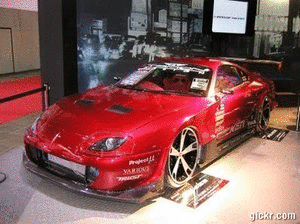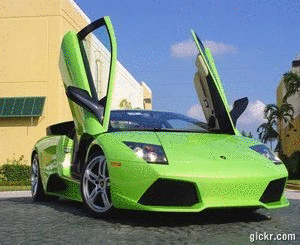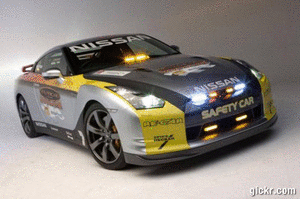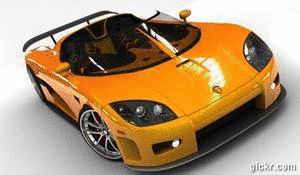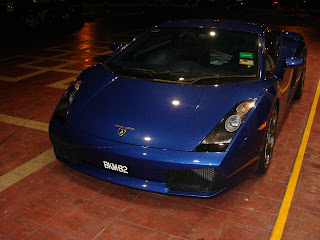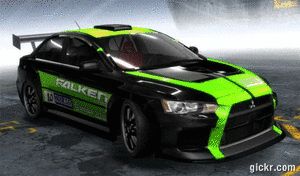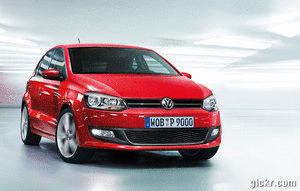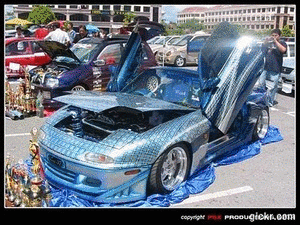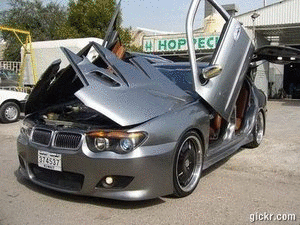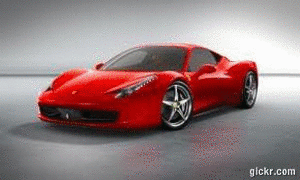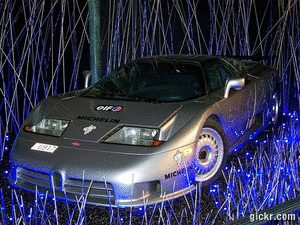Source by: http://auto.howstuffworks.com/rotary-engine4.htm
Rotary Engine Power
Rotary engines use the four-stroke combustion cycle, which is the same cycle that four-stroke piston engines use. But in a rotary engine, this is accomplished in a completely different way.
The heart of a rotary engine is the rotor. This is roughly the equivalent of the pistons in a piston engine. The rotor is mounted on a large circular lobe on the output shaft. This lobe is offset from the centerline of the shaft and acts like the crank handle on a winch, giving the rotor the leverage it needs to turn the output shaft. As the rotor orbits inside the housing, it pushes the lobe around in tight circles, turning three times for every one revolution of the rotor.
As the rotor moves through the housing, the three chambers created by the rotor change size. This size change produces a pumping action. Let's go through each of the four strokes of the engine looking at one face of the rotor.
Intake
The intake phase of the cycle starts when the tip of the rotor passes the intake port. At the moment when the intake port is exposed to the chamber, the volume of that chamber is close to its minimum. As the rotor moves past the intake port, the volume of the chamber expands, drawing air/fuel mixture into the chamber.
When the peak of the rotor passes the intake port, that chamber is sealed off and compression begins.
Compression
As the rotor continues its motion around the housing, the volume of the chamber gets smaller and the air/fuel mixture gets compressed. By the time the face of the rotor has made it around to the spark plugs, the volume of the chamber is again close to its minimum. This is when combustion starts.
Combustion
Most rotary engines have two spark plugs. The combustion chamber is long, so the flame would spread too slowly if there were only one plug. When the spark plugs ignite the air/fuel mixture, pressure quickly builds, forcing the rotor to move.
The pressure of combustion forces the rotor to move in the direction that makes the chamber grow in volume. The combustion gases continue to expand, moving the rotor and creating power, until the peak of the rotor passes the exhaust port.
Exhaust
Once the peak of the rotor passes the exhaust port, the high-pressure combustion gases are free to flow out the exhaust. As the rotor continues to move, the chamber starts to contract, forcing the remaining exhaust out of the port. By the time the volume of the chamber is nearing its minimum, the peak of the rotor passes the intake port and the whole cycle starts again.
The neat thing about the rotary engine is that each of the three faces of the rotor is always working on one part of the cycle -- in one complete revolution of the rotor, there will be three combustion strokes. But remember, the output shaft spins three times for every complete revolution of the rotor, which means that there is one combustion stroke for each revolution of the output shaft.
|
|
|---|
Lamborghini Gallardo
How Rotary Engines Work (Part 4)
Source by: http://auto.howstuffworks.com/rotary-engine3.htm
Rotary Engine Assembly
A rotary engine is assembled in layers. The two-rotor engine we took apart has five main layers that are held together by a ring of long bolts. Coolant flows through passageways surrounding all of the pieces.
The two end layers contain the seals and bearings for the output shaft. They also seal in the two sections of housing that contain the rotors. The inside surfaces of these pieces are very smooth, which helps the seals on the rotor do their job. An intake port is located on each of these end pieces.
 One of the two end pieces of a two-rotor Wankel engine
One of the two end pieces of a two-rotor Wankel engine
The next layer in from the outside is the oval-shaped rotor housing, which contains the exhaust ports. This is the part of the housing that contains the rotor.
The part of the rotor housing that holds the rotors
 (Note the exhaust port location.)
(Note the exhaust port location.)
The center piece contains two intake ports, one for each rotor. It also separates the two rotors, so its outside surfaces are very smooth.

The center piece contains another intake port for each rotor.
In the center of each rotor is a large internal gear that rides around a smaller gear that is fixed to the housing of the engine. This is what determines the orbit of the rotor. The rotor also rides on the large circular lobe on the output shaft.
Next, we'll see how the engine actually makes power.
Rotary Engine Assembly
A rotary engine is assembled in layers. The two-rotor engine we took apart has five main layers that are held together by a ring of long bolts. Coolant flows through passageways surrounding all of the pieces.
The two end layers contain the seals and bearings for the output shaft. They also seal in the two sections of housing that contain the rotors. The inside surfaces of these pieces are very smooth, which helps the seals on the rotor do their job. An intake port is located on each of these end pieces.
 One of the two end pieces of a two-rotor Wankel engine
One of the two end pieces of a two-rotor Wankel engineThe next layer in from the outside is the oval-shaped rotor housing, which contains the exhaust ports. This is the part of the housing that contains the rotor.
The part of the rotor housing that holds the rotors
 (Note the exhaust port location.)
(Note the exhaust port location.)The center piece contains two intake ports, one for each rotor. It also separates the two rotors, so its outside surfaces are very smooth.

The center piece contains another intake port for each rotor.
In the center of each rotor is a large internal gear that rides around a smaller gear that is fixed to the housing of the engine. This is what determines the orbit of the rotor. The rotor also rides on the large circular lobe on the output shaft.
Next, we'll see how the engine actually makes power.
How Rotary Engines Work (Part 3)
Source by: http://auto.howstuffworks.com/rotary-engine2.htm
The Parts of a Rotary Engine
A rotary engine has an ignition system and a fuel-delivery system that are similar to the ones on piston engines. If you've never seen the inside of a rotary engine, be prepared for a surprise, because you won't recognize much.
Rotor
The rotor has three convex faces, each of which acts like a piston. Each face of the rotor has a pocket in it, which increases the displacement of the engine, allowing more space for air/fuel mixture.

At the apex of each face is a metal blade that forms a seal to the outside of the combustion chamber. There are also metal rings on each side of the rotor that seal to the sides of the combustion chamber.
The rotor has a set of internal gear teeth cut into the center of one side. These teeth mate with a gear that is fixed to the housing. This gear mating determines the path and direction the rotor takes through the housing.
Housing
The housing is roughly oval in shape (it's actually an epitrochoid -- check out this Java demonstration of how the shape is derived). The shape of the combustion chamber is designed so that the three tips of the rotor will always stay in contact with the wall of the chamber, forming three sealed volumes of gas.
Each part of the housing is dedicated to one part of the combustion process. The four sections are:
* Intake
* Compression
* Combustion
* Exhaust

The intake and exhaust ports are located in the housing. There are no valves in these ports. The exhaust port connects directly to the exhaust, and the intake port connects directly to the throttle.
Output Shaft
The output shaft has round lobes mounted eccentrically, meaning that they are offset from the centerline of the shaft. Each rotor fits over one of these lobes. The lobe acts sort of like the crankshaft in a piston engine. As the rotor follows its path around the housing, it pushes on the lobes. Since the lobes are mounted eccentric to the output shaft, the force that the rotor applies to the lobes creates torque in the shaft, causing it to spin.
The output shaft

(Note the eccentric lobes.)
Now let's take a look at how these parts are assembled and how it produces power.
The Parts of a Rotary Engine
A rotary engine has an ignition system and a fuel-delivery system that are similar to the ones on piston engines. If you've never seen the inside of a rotary engine, be prepared for a surprise, because you won't recognize much.
Rotor
The rotor has three convex faces, each of which acts like a piston. Each face of the rotor has a pocket in it, which increases the displacement of the engine, allowing more space for air/fuel mixture.

At the apex of each face is a metal blade that forms a seal to the outside of the combustion chamber. There are also metal rings on each side of the rotor that seal to the sides of the combustion chamber.
The rotor has a set of internal gear teeth cut into the center of one side. These teeth mate with a gear that is fixed to the housing. This gear mating determines the path and direction the rotor takes through the housing.
Housing
The housing is roughly oval in shape (it's actually an epitrochoid -- check out this Java demonstration of how the shape is derived). The shape of the combustion chamber is designed so that the three tips of the rotor will always stay in contact with the wall of the chamber, forming three sealed volumes of gas.
Each part of the housing is dedicated to one part of the combustion process. The four sections are:
* Intake
* Compression
* Combustion
* Exhaust

The intake and exhaust ports are located in the housing. There are no valves in these ports. The exhaust port connects directly to the exhaust, and the intake port connects directly to the throttle.
Output Shaft
The output shaft has round lobes mounted eccentrically, meaning that they are offset from the centerline of the shaft. Each rotor fits over one of these lobes. The lobe acts sort of like the crankshaft in a piston engine. As the rotor follows its path around the housing, it pushes on the lobes. Since the lobes are mounted eccentric to the output shaft, the force that the rotor applies to the lobes creates torque in the shaft, causing it to spin.
The output shaft

(Note the eccentric lobes.)
Now let's take a look at how these parts are assembled and how it produces power.
How Rotary Engines Work (Part 2)
Source by: http://auto.howstuffworks.com/rotary-engine1.htm
Principles of a Rotary Engine
Like a piston engine, the rotary engine uses the pressure created when a combination of air and fuel is burned. In a piston engine, that pressure is contained in the cylinders and forces pistons to move back and forth. The connecting rods and crankshaft convert the reciprocating motion of the pistons into rotational motion that can be used to power a car.
In a rotary engine, the pressure of combustion is contained in a chamber formed by part of the housing and sealed in by one face of the triangular rotor, which is what the engine uses instead of pistons.
The rotor and housing of a rotary engine from a Mazda RX-7: These parts replace the pistons, cylinders, valves, connecting rods and camshafts found in piston engines.
The rotor follows a path that looks like something you'd create with a Spirograph. This path keeps each of the three peaks of the rotor in contact with the housing, creating three separate volumes of gas. As the rotor moves around the chamber, each of the three volumes of gas alternately expands and contracts. It is this expansion and contraction that draws air and fuel into the engine, compresses it and makes useful power as the gases expand, and then expels the exhaust.
We'll be taking a look inside a rotary engine to check out the parts, but first let's take a look at a new model car with an all-new rotary engine.
Mazda RX-8
Mazda has been a pioneer in developing production cars that use rotary engines. The RX-7, which went on sale in 1978, was probably the most successful rotary-engine-powered car. But it was preceded by a series of rotary-engine cars, trucks and even buses, starting with the 1967 Cosmo Sport. The last year the RX-7 was sold in the United States was 1995, but the rotary engine is set to make a comeback in the near future.
The Mazda RX-8 , a new car from Mazda, has a new, award winning rotary engine called the RENESIS. Named International Engine of the Year 2003, this naturally aspirated two-rotor engine will produce about 250 horsepower.
Principles of a Rotary Engine
Like a piston engine, the rotary engine uses the pressure created when a combination of air and fuel is burned. In a piston engine, that pressure is contained in the cylinders and forces pistons to move back and forth. The connecting rods and crankshaft convert the reciprocating motion of the pistons into rotational motion that can be used to power a car.
In a rotary engine, the pressure of combustion is contained in a chamber formed by part of the housing and sealed in by one face of the triangular rotor, which is what the engine uses instead of pistons.
The rotor and housing of a rotary engine from a Mazda RX-7: These parts replace the pistons, cylinders, valves, connecting rods and camshafts found in piston engines.
The rotor follows a path that looks like something you'd create with a Spirograph. This path keeps each of the three peaks of the rotor in contact with the housing, creating three separate volumes of gas. As the rotor moves around the chamber, each of the three volumes of gas alternately expands and contracts. It is this expansion and contraction that draws air and fuel into the engine, compresses it and makes useful power as the gases expand, and then expels the exhaust.
We'll be taking a look inside a rotary engine to check out the parts, but first let's take a look at a new model car with an all-new rotary engine.
Mazda RX-8
Mazda has been a pioneer in developing production cars that use rotary engines. The RX-7, which went on sale in 1978, was probably the most successful rotary-engine-powered car. But it was preceded by a series of rotary-engine cars, trucks and even buses, starting with the 1967 Cosmo Sport. The last year the RX-7 was sold in the United States was 1995, but the rotary engine is set to make a comeback in the near future.
The Mazda RX-8 , a new car from Mazda, has a new, award winning rotary engine called the RENESIS. Named International Engine of the Year 2003, this naturally aspirated two-rotor engine will produce about 250 horsepower.
How Rotary Engines Work (Part 1)
Source by: http://auto.howstuffworks.com/rotary-engine.htm
Introduction to How Rotary Engines Work
A rotary engine is an internal combustion engine, like the engine in your car, but it works in a completely different way than the conventional piston engine.
 In a piston engine, the same volume of space (the cylinder) alternately does four different jobs -- intake, compression, combustion and exhaust. A rotary engine does these same four jobs, but each one happens in its own part of the housing. It's kind of like having a dedicated cylinder for each of the four jobs, with the piston moving continually from one to the next.
In a piston engine, the same volume of space (the cylinder) alternately does four different jobs -- intake, compression, combustion and exhaust. A rotary engine does these same four jobs, but each one happens in its own part of the housing. It's kind of like having a dedicated cylinder for each of the four jobs, with the piston moving continually from one to the next.
The rotary engine (originally conceived and developed by Dr. Felix Wankel) is sometimes called a Wankel engine, or Wankel rotary engine.
 In this article, we'll learn how a rotary engine works. Let's start with the basic principles at work.
In this article, we'll learn how a rotary engine works. Let's start with the basic principles at work.
Introduction to How Rotary Engines Work
A rotary engine is an internal combustion engine, like the engine in your car, but it works in a completely different way than the conventional piston engine.
 In a piston engine, the same volume of space (the cylinder) alternately does four different jobs -- intake, compression, combustion and exhaust. A rotary engine does these same four jobs, but each one happens in its own part of the housing. It's kind of like having a dedicated cylinder for each of the four jobs, with the piston moving continually from one to the next.
In a piston engine, the same volume of space (the cylinder) alternately does four different jobs -- intake, compression, combustion and exhaust. A rotary engine does these same four jobs, but each one happens in its own part of the housing. It's kind of like having a dedicated cylinder for each of the four jobs, with the piston moving continually from one to the next.The rotary engine (originally conceived and developed by Dr. Felix Wankel) is sometimes called a Wankel engine, or Wankel rotary engine.
 In this article, we'll learn how a rotary engine works. Let's start with the basic principles at work.
In this article, we'll learn how a rotary engine works. Let's start with the basic principles at work.
How Rotary Engines Work (Part 6)
Source by: http://auto.howstuffworks.com/rotary-engine5.htm
Differences and Challenges
There are several defining characteristics that differentiate a rotary engine from a typical piston engine.
Fewer Moving Parts
The rotary engine has far fewer moving parts than a comparable four-stroke piston engine. A two-rotor rotary engine has three main moving parts: the two rotors and the output shaft. Even the simplest four-cylinder piston engine has at least 40 moving parts, including pistons, connecting rods, camshaft, valves, valve springs, rockers, timing belt, timing gears and crankshaft.
This minimization of moving parts can translate into better reliability from a rotary engine. This is why some aircraft manufacturers (including the maker of Skycar) prefer rotary engines to piston engines.
Smoother
All the parts in a rotary engine spin continuously in one direction, rather than violently changing directions like the pistons in a conventional engine do. Rotary engines are internally balanced with spinning counterweights that are phased to cancel out any vibrations.
The power delivery in a rotary engine is also smoother. Because each combustion event lasts through 90 degrees of the rotor's rotation, and the output shaft spins three revolutions for each revolution of the rotor, each combustion event lasts through 270 degrees of the output shaft's rotation. This means that a single-rotor engine delivers power for three-quarters of each revolution of the output shaft. Compare this to a single-cylinder piston engine, in which combustion occurs during 180 degrees out of every two revolutions, or only a quarter of each revolution of the crankshaft (the output shaft of a piston engine).
Slower
Since the rotors spin at one-third the speed of the output shaft, the main moving parts of the engine move slower than the parts in a piston engine. This also helps with reliability.
Challenges
There are some challenges in designing a rotary engine:
- Typically, it is more difficult (but not impossible) to make a rotary engine meet U.S. emissions regulations.
- The manufacturing costs can be higher, mostly because the number of these engines produced is not as high as the number of piston engines.
- They typically consume more fuel than a piston engine because the thermodynamic efficiency of the engine is reduced by the long combustion-chamber shape and low compression ratio.
Differences and Challenges
There are several defining characteristics that differentiate a rotary engine from a typical piston engine.
Fewer Moving Parts
The rotary engine has far fewer moving parts than a comparable four-stroke piston engine. A two-rotor rotary engine has three main moving parts: the two rotors and the output shaft. Even the simplest four-cylinder piston engine has at least 40 moving parts, including pistons, connecting rods, camshaft, valves, valve springs, rockers, timing belt, timing gears and crankshaft.
This minimization of moving parts can translate into better reliability from a rotary engine. This is why some aircraft manufacturers (including the maker of Skycar) prefer rotary engines to piston engines.
Smoother
All the parts in a rotary engine spin continuously in one direction, rather than violently changing directions like the pistons in a conventional engine do. Rotary engines are internally balanced with spinning counterweights that are phased to cancel out any vibrations.
The power delivery in a rotary engine is also smoother. Because each combustion event lasts through 90 degrees of the rotor's rotation, and the output shaft spins three revolutions for each revolution of the rotor, each combustion event lasts through 270 degrees of the output shaft's rotation. This means that a single-rotor engine delivers power for three-quarters of each revolution of the output shaft. Compare this to a single-cylinder piston engine, in which combustion occurs during 180 degrees out of every two revolutions, or only a quarter of each revolution of the crankshaft (the output shaft of a piston engine).
Slower
Since the rotors spin at one-third the speed of the output shaft, the main moving parts of the engine move slower than the parts in a piston engine. This also helps with reliability.
Challenges
There are some challenges in designing a rotary engine:
- Typically, it is more difficult (but not impossible) to make a rotary engine meet U.S. emissions regulations.
- The manufacturing costs can be higher, mostly because the number of these engines produced is not as high as the number of piston engines.
- They typically consume more fuel than a piston engine because the thermodynamic efficiency of the engine is reduced by the long combustion-chamber shape and low compression ratio.
Haltech R32/33 Platinum Pro Plug-in
R32/33 Platinum Pro Plug-in
• Uses the cars factory sensors
• Supports R32 GT-R twin MAF sensors
• Supports Sequential Injection (peak and hold) and Direct fire ignition
• Windows 2000, XP, Vista compatible software
• Real time programming, instant hesitation free adjustment while engine is running
• Fully user definable 32 x 32 mapping
• Tuning via Volumetric Efficiency (VE), Injection time or Lambda Correction (MAF)
• Selectable onboard internal MAP sensor rated to 150kPa (up to 1.5 Bar or 22psi boost)
• Wideband “auto tuning” using user definable target AFR table
• USB and CAN Communication Port
• 6 x Fuel Injector outputs
• 6 x Ignition outputs
• Tacho, Boost Control, AC Clutch Relay, Idle Control
• Thermo Fan, Check Engine Light, Fuel Pump (Variable Speed)
• N-VCT ( Nissan Variable CAM Timing Control)
• MAF sensors, Throttle Position Sensor, Oxygen sensors,
• Coolant Temperature sensor, Vehicle Speed Sensor,
• Air Temperature sensor.
• 2 x Analogue Voltage inputs
• 2 x Analogue Temperature inputs
• 4 x Digital pulsed outputs
*Optional auxiliary harness required to be purchased Haltech Part # HT040003
• Closed Loop O2 Control
• Decel Cut Over Boost Rev Limiter
• Closed & Open Loop Boost Control
• Gear Setup
• ACF On Base Tables
• Transient Throttle Enhance
• Cranking
• Air Temp Target Correction
• Coolant Temperature Correction
• Map Correction
• Zero Throttle Gear Correction
• Cylinder Trim
• TPS Correction
• Generic Correction 1
• Generic Correction 2
• Gear Correction
• Post Start
• Air Temp Duty Correction
• Post Start
Miscellaneous:
• Data Logging: 448Kb of onboard data logging, Storage for approx 40 minutes at 10 logs per seconds, 6 channels of data
• Max 20 channels logging capability
• Tune can be password protected in software
• Rugged anodized aluminum casing
Source: 8.6 to 16.5 Volts DC
Consumption: 530mA @ 12Volts DC
ECU Dimensions Length: 154mm (174mm with MAP nipple)
Width: 158mm Height: 42mm Weight: 680g (1.5 lb)
Applications: Nissan Skyline R32, Nissan Skyline R33
Variations: GT-R, GTS-t
Engine Codes: RB25DET, RB26DETT
Transmission: Manual only (Automatic not supported)
The R32/33 Platinum Pro Plug-in Kit includes: Pro Plug-in ECU, USB Cable, Programming Software CD, Quick Start Guide, Instruction Manual (on CD) |
Subscribe to:
Comments (Atom)
